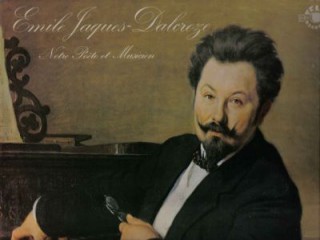
Emile Jaques-Dalcroze biography
Date of birth : 1865-07-06
Date of death : 1950-07-01
Birthplace : Vienna, Austria
Nationality : Swiss
Category : Famous Figures
Last modified : 2011-04-05
Credited as : Composer and teacher, developed eurhythmics, the Methode Jaques-Dalcroze (1906)
Emile Jaques-Dalcroze was a Swiss teacher and composer known for developing eurhythmics, an approach to music education involving whole body movement.
Born July 6, 1865, Emile-Henri Jaques was the only son of Jules-Louis and Julie Jaques, a French-Swiss couple living in Vienna, where his father represented Swiss clockmakers. Emile and his sister were introduced as children to concerts, theater, opera, and piano lessons. After the family moved to Geneva Emile studied at the Conservatoire de Musique (1877-1883) and continued his professional training in Paris and Vienna (1884-1891) with Talbot, Faure, Lavignac, Marmontel, Lussy, Graedener, Prosnitz, Fuchs, and Bruckner. He worked one season as a conductor at the Theatre des Nouveautes in Algiers, where North African music stimulated his interest in the connections of human movement and rhythm.
Emile Jaques began to compose seriously during his early 20s and soon changed his name to the more distinctive Jaques-Dalcroze, perhaps to avoid confusion with a French composer famous for his polkas. His extensive works included music for orchestra, chamber orchestra, and piano; music dramas; operas; choral works; some 1,700 songs; and many books relating
In 1892 Jaques-Dalcroze was named a professor at the Conservatoire de Musique de Geneve, where he remained until 1910. During the 1890s he searched for better ways to help his students hear accurately and respond spontaneously. "Rhythmic gymnastics," as Jaques-Dalcroze called his special movement work, offered many new ways to move and make music with the original instrument, the human body. Working from the basics of singing, breathing, walking, and beating time, Jaques-Dalcroze and his early students eventually explored more adventurous possibilities of connecting music and movement. Lunging, skipping, pulling a partner, carrying an imaginary weight, making a cannon—these called for timing, strength, greater use of the body in space, imagination, awareness of form, and/or cooperation with other people.
Many exercises in the method were based on walking, which Jaques-Dalcroze took to be the natural breakdown of time into equal parts. For example, students might be told to walk around the room following the music which he would improvise at the keyboard, responding directly to the beat and to changes in speed and dynamics. Students would thus become aware of how they had to adjust the length of their steps and how they needed to control their use of energy and body weight. Other typical activities included quick reactions such as starting or stopping on command and walking twice as fast or twice as slow. Another basic practice was the walking or stepping out of rhythmic patterns. The teacher would play a musical example. After listening carefully, the students would immediately repeat it, matching their steps exactly to the sequence of short and long notes they perceived. Work to develop the sense of measure or bartime was developed from the standard arm gestures of conducting. Experienced students could beat regular bartime with their arms while simultaneously stepping rhythmic patterns.
Breathing was understood by Jaques-Dalcroze to be a natural source of dynamics and phrasing. He created many exercises to help students feel how they could shape the flow and energy of breathing. Ideas to encourage the sense of phrasing also included contrasting light and heavy steps, using a real or imagined resistance such as stretching an elastic, or taking turns moving with a partner or in groups. This work led to "realizations" of more complex forms such as inventions, fugues, and rondos. Sometimes students even created "plastic counterpoint," or movement independent of, but related to, its music. Jaques-Dalcroze saw the new work of solo dancers such as Loie Fuller and Isadora Duncan, who inspired him and confirmed his own experiments between 1900 and 1910. Like Duncan, Jaques-Dalcroze explored movement through deep research into the natural movements of breathing, walking, lunging, running, skipping, and jumping.
Jaques-Dalcroze made his work known by giving lecture-demonstrations and publishing The Methode Jaques-Dalcroze (1906), which appeared in both French and German editions. From 1910 to 1914 he directed the Bildungsanstalt Jaques-Dalcroze, a training college built to support his work at Hellerau near Dresden, Germany. Hundreds of teachers and professional students were attracted to this forward-looking school, which offered solfege (ear training), rhythmic gymnastics, keyboard improvisation, plastique (advanced music-movement study), music theory and practice, Swedish gymnastics, dance, and anatomy.
The Hellerau school festivals of 1912 and 1913 included a student version of Gluck's Orpheus, based on the new movement principles of Jaques-Dalcroze and using the new architectural theater designs and lighting concepts of Adolphe Appia. Among the faculty and students of Hellerau were people who became prominent in music, dance, theater, and many other fields. Many helped to spread the Jaques-Dalcroze method by teaching in conservatories and schools throughout Europe and North America. The method came to be known in English as eurhythmics, which means good or right rhythm. The early exercises were continually renewed and elaborated, however, so that eurhythmics has always been developing and is, in fact, still a vital method.
During World War I Jaques-Dalcroze established his own school in Geneva, the Institut Jaques-Dalcroze, where he taught until shortly before his death on July 1, 1950. The institute, now state-supported, serves today as an international center of this approach to music education. Professional training programs are also currently available in a number of other countries. Thousands of people have had contact with the Jaques-Dalcroze method, which has had widespread influence in 20th-century teaching of music and dance.
Jaques-Dalcroze increased understanding of the sources of music and movement in the human body. For nearly 60 years he was an inspiring, imaginative master, whose musicianship and personality helped to form many outstanding teachers and artists. Beyond the circle of his students and associates, his writings stimulated a broad public.
















